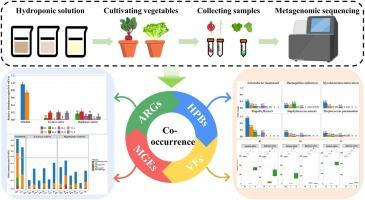硝化沼液水培系统栽培植物抗生素抗性基因的积累和易位
IF 11.3
1区 环境科学与生态学
Q1 ENGINEERING, ENVIRONMENTAL
引用次数: 0
摘要
沼液水培支持养分循环,但由于抗生素抗性基因(ARGs)的传播,引起了生物安全问题。本研究利用硝化沼液建立了生菜和樱桃萝卜水培体系,系统研究了植物组织中ARGs、移动遗传因子(MGEs)、高优先级人致病菌(HPBs)和毒力因子(VFs)的积累情况。ARGs主要在根中积累(0.16 ~ 0.23拷贝/16S rRNA),显著高于叶片(0.01 ~ 0.11拷贝/16S rRNA),且sul1在根际持续富集。过滤预处理显著降低了樱桃萝卜根部ARG和MGE水平,分别降低了30.78%和39.43% (p < 0.05)。ARGs与MGEs呈强相关(R²= 0.97,p < 0.0001),表明水平基因转移是关键的传播途径。共现网络分析显示,ARGs和MGEs与HPBs和VFs具有协同富集作用,强调鲍曼不动杆菌和肺炎链球菌是潜在的核心宿主。这些发现表明,植物体内ARG的积累和扩散受浆液处理、植物种类和组织特异性的影响。虽然过滤降低了风险,但根部持续存在的ARGs需要进一步监测。本研究为农业中沼液的安全再利用策略提供了依据。本文章由计算机程序翻译,如有差异,请以英文原文为准。

Accumulation and translocation of antibiotic resistance genes in plants cultivated in hydroponic systems with nitrified biogas slurry
Hydroponic cultivation with biogas slurry supports nutrient recycling but raises biosafety concerns due to the dissemination of antibiotic resistance genes (ARGs). This study established a hydroponic system using nitrified biogas slurry to grow lettuce and cherry radish, and systematically investigated the accumulation of ARGs, mobile genetic elements (MGEs), high-priority human pathogenic bacteria (HPBs), and virulence factors (VFs) in plant tissues. ARGs predominantly accumulated in roots (0.16 ∼ 0.23 copies/16S rRNA), significantly higher than in leaves (0.01 ∼ 0.11 copies/16S rRNA), with sul1 consistently enriched in the rhizosphere. Filtration pretreatment significantly reduced ARG and MGE levels in cherry radish roots by 30.78 % and 39.43 %, respectively (p < 0.05). ARGs strongly correlated with MGEs (R² = 0.97, p < 0.0001), indicating horizontal gene transfer as the key dissemination pathway. Co-occurrence network analysis revealed synergistic enrichment of ARGs and MGEs with HPBs and VFs, highlighting Acinetobacter baumannii and Streptococcus pneumoniae as potential core hosts. These findings demonstrate that ARG accumulation and spread in plants are affected by slurry treatment, plant species, and tissue specificity. While filtration mitigates risks, persistent ARGs in roots necessitate further monitoring. This study informs safe reuse strategies for biogas slurry in agriculture.
求助全文
通过发布文献求助,成功后即可免费获取论文全文。
去求助
来源期刊

Journal of Hazardous Materials
工程技术-工程:环境
CiteScore
25.40
自引率
5.90%
发文量
3059
审稿时长
58 days
期刊介绍:
The Journal of Hazardous Materials serves as a global platform for promoting cutting-edge research in the field of Environmental Science and Engineering. Our publication features a wide range of articles, including full-length research papers, review articles, and perspectives, with the aim of enhancing our understanding of the dangers and risks associated with various materials concerning public health and the environment. It is important to note that the term "environmental contaminants" refers specifically to substances that pose hazardous effects through contamination, while excluding those that do not have such impacts on the environment or human health. Moreover, we emphasize the distinction between wastes and hazardous materials in order to provide further clarity on the scope of the journal. We have a keen interest in exploring specific compounds and microbial agents that have adverse effects on the environment.
 求助内容:
求助内容: 应助结果提醒方式:
应助结果提醒方式:


